Combing through press releases, mining contacts and reviewing advance publications, the editors of ART iT have sought out the most promising national representations planned for the 54th Venice Biennale. This is a year for bold, ambitious projects that equally combine muscular spectacle with critical rigor. Below are 10 pavilions you won’t want to miss, whether you see them in person or not.
– The Editors
IN COUNTRY: SELECTED NATIONAL REPRESENTATIONS
France – Christian Boltanski: Chance
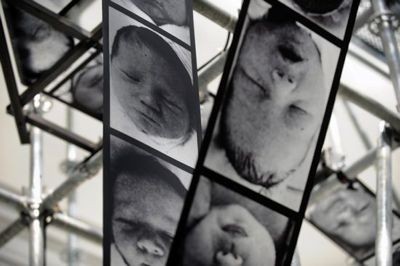
In 2005, Annette Messager won a Golden Lion at the 51st Venice Biennale for her installation reinterpreting the fairy-tale Pinocchio for contemporary times, “The Messengers.” In 2011, Messager’s partner Christian Boltanski is an early frontrunner for taking home this year’s Golden Lion. For “Chance,” he has turned the French Pavilion into environment that is in constant flux, underscored by the room-sized exhibition centerpiece, The Wheel of Fortune, made out of scaffolding and a whizzing conveyor belt of infants’ photographs. Further evoking life’s lottery, the photo-montage multimedia work Be New randomly shuffles the features of different adult and infant faces. With the press of a button, visitors can pause the shifting faces to form a composite whole; like a slot machine, those who manage to line-up all the features of the same face will win the work itself (the game also extends to the Internet through a dedicated website). While the concept for “Chance” parallels in some ways Boltanski’s longtime fascination with disappearance and memory, it also maintains a more positive outlook than previous works: two digital counters on site tally up in realtime the number of births and deaths each day, but the births always outnumber the deaths. Read ART iT’s interview with the artist here.
Curator: Jean-Hubert Martin. Venue: Pavilion at Giardini; Online component: boltanski-chance.com; Image credit: Detail of The Wheel of Fortune from Christian Boltanski’s “Chance” for the French Pavilion, 54th Venice Biennale; Photo Didier Plowy.
Israel – Sigalit Landau: One Man’s Floor is Another Man’s Feelings
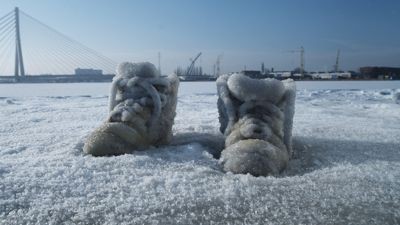
Even in a year with numerous larger-than-life proposals, Sigalit Landau’s project for the Israeli Pavilion stands out as among the most ambitious of the 54th Venice Biennale. Radically reworking its airy, Modernist structure – designed in the International Style by architect Zeev Rechter and completed in the 1950s – Landau has turned the Pavilion into an allegorical space that is part industrial processing plant, part mock-up of the human and social bodies. Visitors entering the Pavilion through a newly installed heavy iron door will encounter an extensive, ad-hoc system of pipes through which flows water from the canal that borders the site. Further within awaits a suite of video works that obliquely address issues of loss, aggression, control and negotiation: a pair of salt-coated shoes sinking into the icy waters of a frozen lake near Gdańsk, Poland; a group of functionaries debating at a conference table as a young girl hidden underneath surreptitiously binds their shoe laces; young men dividing up territory on a beach in a game of strategy. As co-commissioner Ilan Wizgan writes in the catalogue for Landau, “Without being overtly political, the exhibition deals with the political in life and in art, and inherent in it is a criticism of nationalism and national ego, which always undermine rationalism and the positive potential inherent in cooperation and a just distribution of resources and wealth.”
Commissioners: Jean de Loisy and Ilan Wizgan. Venue: Pavilion at Giardini. Image credit: Still from Salt Crystal Shoes on a Frozen Lake (2011), video with sound, 12 min; © Sigalit Landau, courtesy the artist; kamel mennour, Paris; and Givon Gallery, Tel Aviv.
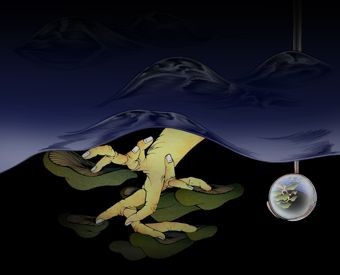
The multimedia artist Tabaimo is known for her installations analyzing contemporary Japan through surreal, hand-drawn animations that resemble ukiyo-e woodblock prints sprung to delirious life. She has previously targeted the kitchen, the bathhouse and even the public restroom as sites for exploring the tensions between community and self. In Venice, she will expand this project to encompass the life-cycle of an entire society, from formless cell to unique individual and nationwide collective. The title of her exhibition, “teleco-soup,” translates roughly to “inverted soup.” Coined by the artist, this phrase in turn riffs on a proverb attributed to the Chinese philosopher Zhuangzi, “A frog in a well cannot conceive of the ocean,” as well as an addendum to the Japanese version of the same, “But it knows the height of the sky.” Employing the unique characteristics of the building, which was designed by architect Takamasa Yoshizaka so that it floats above the ground on pilotis, Tabaimo has turned the interior of the Pavilion into a well and the open space beneath it into the sky. Lined with mirror panels that reflect images projected from multiple sources, this immersive environment destabilizes orientations between up and down, broad and narrow, communal and individual, prompting visitors to question their own relations to society and the world.
Commissioner: Yuka Uematsu. Venue: Pavilion at Giardini. Image credit: teleco-soup (2011), video installation, 5 min 27 sec loop; © Tabaimo, courtesy of Gallery Koyanagi, Tokyo, and James Cohan Gallery, New York.
Norway – The State of Things /
Beyond Death: Viral Discontents and Contemporary Notions about AIDS
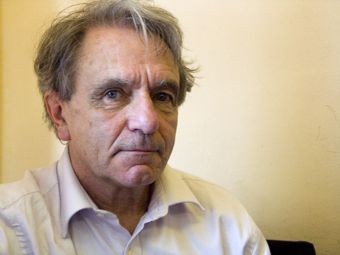
Jacques Rancière
The most memorable national representation at Venice this year may not be a pavilion at all – at least not in the traditional sense – and rather the series of public lectures that the Office for Contemporary Art Norway (OCA) has organized over the course of the Biennale exhibition period. Titled “The State of Things,” the lecture series assesses issues related to contemporary life through a broad range of themes. Jacques Rancière kicks off proceedings June 1 by responding to the question, “In What Time Do We Live?” Also of note are Fawaz A Gerges’ “A Perfect Storm: An Arab Revolution in the Making” (June 4), on the prospects for the democratization of the Arab world; Eyal Weizman’s “Forensic Aesthetics” (June 30), on trauma, forensics, and new interpretations of objectivity and subjectivity; and Judith Butler’s “The Politics of the Street and New Forms of Alliance” (September 7). Amid increasing nationalism and conservatism in Europe and beyond, TJ Clark’s closing lecture, “The Experience of Defeat” (November 17) addresses the ongoing marginalization of the Left in the politics of advanced capitalist societies, asking, “Is a Left with no future a contradiction in terms?” Also part of the Norway representation is the project “Beyond Death: Viral Discontents and Contemporary Notions about AIDS,” carried out by artist Bjarne Melgaard with graduate students at the Faculty of Design and Arts, Università Iuav di Venezia, with an exhibition on view at Palazzo Contarini Corfù until June 31. For complete scheduling information for “The State of Things,” see here.
Commissioner: Office for Contemporary Art Norway (OCA). Venue: Multiple Venues. Image credit: Courtesy Office for Contemporary Art Norway (OCA).
Poland – Yael Bartana: …and Europe will be stunned
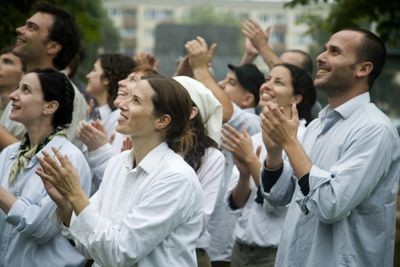
Although it’s still relatively rare, there is a precedent at the Venice Biennale for national representations exhibiting non-national artists. Occasionally such gestures stir contention; increasingly, they elicit hardly any comment at all. Yet the selection of Israeli artist Yael Bartana to represent Poland at this year’s Biennale is not merely an attempt to rethink the borders of Polish contemporary art. It is the culmination of a multi-year project through which Bartana has attempted to rethink Poland itself, and the unsettled legacy of the country’s role in the Holocaust, as well as to rethink the founding myths that have led to Israel’s alienation from its Arab neighbors. Once completed, “…and Europe will be stunned” will comprise a trilogy of films following the activities of a quasi-fictive organization, the Jewish Renaissance Movement in Poland: Mary Koszmary (Nightmares) (2007), in which a young Polish activist gives a speech inviting three million Jews to return to their homeland; Mur i Wieźa (Wall and Tower) (2009), which follows a group of returned Jews erecting a kibbutz-like settlement near a monument to the Warsaw Ghetto Uprising; and a new work, Zamach (Assassination) (2011), in which members of the Jewish Renaissance Movement mourn the assassination of their leader. Modeled on Zionist and other early 20th-century propaganda films, these works are highly ambivalent, withholding from viewers any clear sympathy for either the artist behind the camera or the subjects within its lens. And perhaps this is exactly the point. In the sheer audacity of their collective vision, Bartana’s films push viewers to reflect on their own relations to nationality, and the complacency with which they regard the systems by which they are governed. Read ART iT’s interview with the artist here.
Commissioner: Hana Wróblewska. Curators: Sebastian Cichocki, Galit Eilat. Venue: Pavilion at Giardini. Image credit: Production photo from Mur i wieża (Wall and Tower) (2009); Photo Magda Wunsche & Samsel, courtesy Annet Gelink Gallery, Amsterdam, and Sommer Contemporary Art, Tel Aviv.
Spain – Dora García: The Inadequate
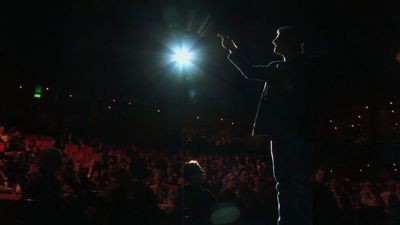
Based in Brussels, Dora García says that her first reaction when told of her selection to represent Spain at Venice was, “embarrassment, malaise; I felt as if something was not quite fitting.” Reflecting on the contradictions of an event like the Biennale – its anachronism, and the absurdity of exhibiting art at such a massive scale – she has turned those initial presentiments into a nebulous performance project that includes over 70 participants, among them the theatre group Accademia della Follia and the late filmmaker Pier Paolo Pasolini. Entitled “The Inadequate,” García’s exhibition continues a trajectory of past works exploring the psychology of performance. In “Inserts in Real Time,” for example, she choreographed situations that blurred the lines between performance, acts of madness, socialized behavior and spectatorship. Similarly, for Skulptur Projekte Münster in 2007, García hired an actor to reinterpret in public spaces across the city the role of the beggar Filch from John Gay’s The Beggar’s Opera (1728) and its 1928 adaptation by Bertolt Brecht, The Threepenny Opera. Visitors to Venice should prepare to find themselves in the middle of “The Inadequate” before they even know it. Those who are unable to see the Biennale in person can follow all the action on a dedicated website, another hallmark of García’s genre-bending investigation into modes of interactivity. Read ART iT’s interview with the artist here.
Curator: Katya García-Antón. Venue: Pavilion at Giardini. Online component: theinadequate.net. Image credit: Still from Just Because Everything Is Different It Does Not Mean That Anything Has Changed, Lenny Bruce In Sydney (2008), video HD, 60 min; Collection Centro de Arte Dos de Mayo, CA2M, Móstoles, Madrid.
Switzerland – Thomas Hirschhorn: Crystal of Resistance /
Andrea Thal: Chewing the Scenery
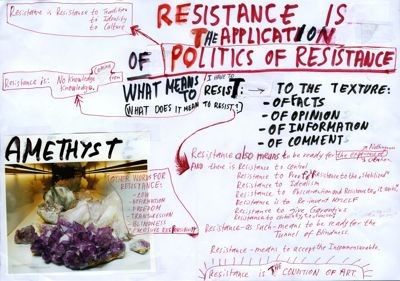
Thomas Hirschhorn has previously said that he is interested in the “too much,” a term that refers both to the material and informational over-saturation of contemporary consumer culture and also the special rawness through which art – or specifically, the artist – communicates with the world. Embodying this aesthetic, Hirschhorn’s Swiss Pavilion will constitute a sensory tour de force. As visualized in sketches and work-in-progress photos, the installation does not respond to the pavilion architecture so much as it envelopes it, transforming the interior into a giant, foil-covered cavern pierced through by makeshift crystal formations to suggest the appearance of a Sci-Fi B-movie set or a deranged crystal meth lab. Other elements include a column of TV sets, mannequins, smashed car windshields, foil-covered exercise equipment and plastic chairs infested by grids of junked mobilephone handsets. If this approach expresses a necessary degree of machismo, it also obliterates the labored contextualization – in terms of both national posturing and critical irony – that has historically defined the Biennale. As Hirschhorn writes in an artist statement, “I want to create a place that is so strange, so entirely from myself – only from myself – and so distinct that it becomes universal.” Organized by curator Andrea Thal, Switzerland’s other representation at Venice this year is a multi-part project involving a film installation, an “installative dramatization,” live events and an evolving publication. See details online here.
Thomas Hirschhorn – Commissioner: Urs Staub. Venue: Pavilion at Giardini. Online component: crystalofresistance.com. Image credit: Sketch for “Crystal of Resistance” (2011). / Chewing the Scenery – Commissioner: Andreas Münch. Venue: Teatro Fondamenta Nuove.
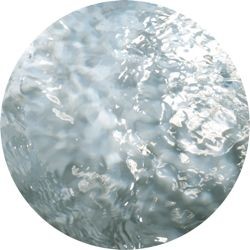
Alongside maximalist, immersive installations, water seems to be a trending theme at this year’s Venice Biennale. For the Turkish Pavilion, Ayşe Erkmen will convert a room inside the Arsenale into a functioning, yet ultimately futile water purification unit: all the potable water it produces will be released back into the Venetian canals. Erkmen is best known for minimalist sculptural interventions that can produce dramatic results, as with Busy Colors (2005) at New York’s SculptureCenter, where she fixed bright red and blue fabrics to an automated gantry crane that swept back-and-forth across the exhibition space. “Plan B” is necessarily somewhat more concrete, with Erkmen connecting each component of her sculptural purification unit through a winding network of pipes in order to underscore the complex processes of transformation at play. In turning industry into art and subverting the typical efficiency of pragmatic design, the work establishes a metaphoric relationship between the flow of water through the purification unit and the flow of blood through the body or the flow of capital through markets and across international borders, as well as to the contingencies that give concrete form to idealized concepts.
Curator: Fulya Erdemci; Deputy Curator: Danae Mossman; Venue: Pavilion at Arsenale; Image credit: From “Plan B” (2011); Photo Serdar Tanyeli.
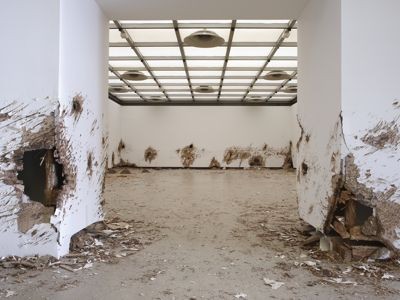
The most secretive entry at this year’s Venice Biennale is Mike Nelson’s British Pavilion. Famed for making architecture-scale environments that transform the viewer’s progress through space into a narrative or even psychedelic experience, Nelson has been working on site in the Giardini since March, yet as of this writing no title for his project and barely any details of what it entails have been released. The artist typically draws upon a wide array of references in constructing his environments, from the writers HP Lovecraft and Jorge Luis Borges to cultural signifiers such as oriental carpets and classic American Jetstream trailers. Assembled from the detritus of everyday life, works such as The Pumpkin Palace (2003) – a vintage Red Crescent bus that was converted into a multi-room opium den – create haunted fields in which each diverse component projects its own history and psychic resonance into a heterogenous shared space. Whether Nelson chooses to address the host city’s history as a gateway between Europe and Asia, British nationality or any other topic, his will surely be one of the most impressive exhibitions at Venice, and well worth anticipating.
Commissioner: Andrea Rose. Curator: Richard Riley. Venue: Pavilion at Giardini. Image credit To the Memory of HP Lovecraft 3 (London, 2008); Photo Steve White, courtesy Matt’s Gallery, London; Franco Noero, Turin; and 303 Gallery, New York.
US – Allora & Calzadilla: Gloria
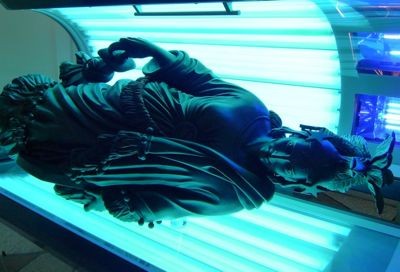
As soon as they announced their plans for the US Pavilion, the artist duo Allora & Calzadilla invited a summer full of commentary on their appropriation of the Venice Biennale’s unofficial moniker, the “artworld Olympics.” They are producing a group of new sculptural works that serve as platforms for performances by athletes associated with USA Gymnastics and USA Track & Field, the national governing bodies for their respective disciplines. However, it would seem that the consistently poetic and inventive artists are interested not so much in drawing comparisons between art and sport as they are in using sport to exquisitely satire the testosterone-fueled hubris of Corporate America. Full-scale, carved wooden replicas of business-class airplane seats, Body in Flight (Delta) and Body in Flight (American) (all works 2011) will serve as the rough equivalents to the balance beam and pommel horse used for gymnastic routines. Placed outdoors in front of the US Pavilion, Track and Field adapts an overturned military tank into a repurposed, functioning treadmill. Also on display will be a custom-made pipe organ that houses a functioning ATM machine (with each cash withdrawal, the ATM triggers a new musical score played back through the organ), as well as a bronze replica of the Statue of Freedom – hoisted by slave labor to its home atop the US Capitol building in 1863 – reclining in a Solaris 442 sunbed. Read Dan Cameron’s essay profiling Allora & Calzadilla for ART iT here.
Commissioner: Lisa D Freiman. Venue: Pavilion at Giardini. Image credit: Installation view of Armed Freedom Lying in a Sunbed in the US Pavilion at the Giardini, Venice, 2011; Photo ART iT.
ALSO OF NOTE
Egypt – Ahmed Basiony: 30 Days of Running in the Space
In recent years Egypt’s exhibitions at Venice have tended towards underwhelming presentations of Orientalist pastiche. That will change with “30 Days of Running in the Space,” a multimedia installation honoring artist and musician Ahmed Basiony (1978-2011), who was killed January 28 while shooting video in Tahrir Square of the initial protests that led to the overthrow of the Hosni Mubarak regime.
Commissioner: Shady El Noshokaty. Curator: Aida Eltorie. Venue: Pavilion at Giardini.
India – Everyone Agrees: It’s About to Explode
India’s first official participation at Venice after several privately initiated presentations, this exhibition curated by Ranjit Hoskote will reconsider nationality, territory and identity through the work of four artists and groups based both within India and beyond. Read ART iT’s interview with participating artist Zarina Hashmi here.
Commissioner: Ranjit Hoskote. Venue: Pavilion at Arsenale.
Russia – Andrei Monastyrski and the Collective Actions Group: Empty Zones
Curated by Boris Groys, the Russian Pavilion is one of the more theory-driven entries to this year’s Venice Bienale. Already, Groys has convened a symposium in Moscow on Russia’s relationship to the legacy of conceptual art, featuring international speakers including Terry Smith, Chus Martinez and Jörg Heiser. Focusing on the pioneering participatory art group Collective Actions, the exhibition itself will attempt to articulate “the concept of life as a unique kind of artwork.”
Commissioner: Stella Kesaeva. Curator: Boris Groys. Venue: Pavilion at Giardini.
Thailand – Navin Rawanchaikul: Paradiso di Navin
Navin Rawanchaikul was born in Thailand to parents with Hindu-Punjabi roots and is now a permanent resident of Japan. Building on this personal narrative, through “Paradiso di Navin” he plans to deconstruct the system of national representations that defines the Venice Biennale. Read ART iT’s interview with the artist here.
Commissioner: Prisna Pongtadsirikul. Curators: Pandit Chanrochanakit, Steven Pettifor. Venue: Paradiso Gallerie, Giardini della Biennale.
UAE – Second Time Around
In 2009, the UAE’s first official representation at Venice turned a reflexive gaze on the use of culture in the Emirates’ ongoing nation-building project. This year’s follow-up presentation curated by Vasif Kortun shifts the focus squarely on art itself, with a group show of works in disparate media and approaches by Reem Al Ghaith, Abdullah Al Saadi and Lateefa Bint Maktoum. Read ART iT’s interview with Vasif Kortun here.
Commissioner: Hamdan Lamees. Curator: Vasif Kortun. Venue: Pavilion at Arsenale.
Return to story index
Venice Biennale – ILLUMInations: 54th International Art Exhibition
